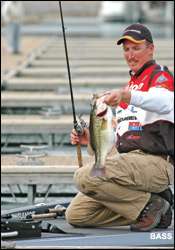
Alabama pro Jimmy Mason has gotten into the habit of catching bass under floating docks with a shallow running crankbait. Mason first tried the technique several years ago while fishing a regional tournament at Neely Henry Lake in Alabama.
After struggling to coax bass from floating docks on a variety of other lures, he cranked the docks with a 2A Bomber, which runs 3 to 4 feet deep. Mason knew he was onto something when he quickly loaded his livewell with spotted bass. Then it became habit forming.
"I've played a lot with it since then and have a lot of confidence in it," Mason said. "It's a great way to cover water fast and trigger reaction bites when most fishermen are poking around docks with jigs and finesse baits."
Cranking docks keeps Mason flush with spotted and largemouth bass once warmer weather arrives. This strategy remains productive through the fall months, he added. In the spring, usually beginning in April, he concentrates on docks in the backs of creeks near spawning areas. He hits main lake docks when bass move out of the creeks in the summertime. As shad migrate into the creeks in autumn, Mason follows them in and cranks docks near concentrations of these baitfish.
The bottom composition below a floating dock is of little importance because bass suspend under the dock. However, a dock near a creek or river channel that swings away from the back is especially productive.
"The water under the dock could be any depth," Mason explained. "But, if I had to pick the perfect dock, it would be over 8 to 15 feet of water."
Mason has found that dock designs often vary from one lake to the next, because different companies typically supply docks to certain areas. He adjusts his presentation to run his crankbait past the key places bass hold on particular docks.
On Wheeler, Mason's home lake, corner posts anchored to the bottom hold most floating docks in place. Builders typically thread a metal ring on each corner of the dock, which allows the dock to rise and fall with the water level.
Mason strives to "clip" one of these corner posts with his crankbait on every cast. He starts by making parallel casts along the front of the dock. Then he runs his crankbait parallel to each side of the dock. He finishes by cranking the back of the dock under the walkway.
"I'll make several casts to each post," Mason detailed. "If I feel certain the dock holds a bass, I might make 10 to 15 consecutive casts to the same post."
When he's fishing floating docks that are held to the shore with cables, Mason targets the cable where it connects to the dock under the surface. Similarly, he repeatedly targets the cable and the connection with his crankbait.
Boat slips often have an underwater beam across the entrance that braces one side of the slip against the other. Bass relate to the crossbeam, and Mason picks them off by bumping the beam with his crankbait. If the 2A Bomber doesn't dive deep enough to reach the beam, Mason switches to a 4A Bomber, giving him a 6-foot depth zone to target.
Whatever the dock design or the season, Mason always uses an upbeat medium retrieve.
"I'm trying to get a reaction bite," he emphasized.
"I get a lot of strikes when I stop cranking for a second after the crankbait ricochets off something."
Mason likes the 2A Bomber for its wide, rolling wobble and the way it bounces off dock posts, cables and crossbeams without picking up the algae that usually grows on these objects. But it's certainly not the only crankbait he uses.
"I switch to a Shallow Fat Free Shad when I'm fishing floating docks in dingy water. It doesn't shed algae as well as the 2A, but it has a tighter, harder wiggle that works better in dirty water."
When bass feed on spawning bluegill in late May through early June, Mason opts for a firetiger or chartreuse pattern in an attempt to mimic this forage. Outside this window, he sticks with the Tennessee shad pattern, since bass feed mainly on shad.
A 7-foot Kistler magnesium composite crankbait rod handles Mason's dock cranking chores. He matches the rod with Silver Thread AN40 line (green) and a Pflueger Trion 5.2:1 baitcasting reel. "I'm a big believer in a slower reel for all my crankbait fishing. I think I get more bites by not overworking my crankbaits."
Marinas lend themselves to Mason's dock-cranking ploy, but he claims that only a few of the many boat slips in an average marine complex will produce bass consistently.
"To maximize your fishing in a marina, you have to fish every slip in practice to find the good ones. Then you crank only those slips in the tournament and skip the rest."





